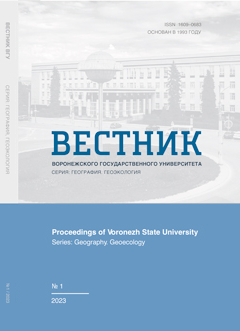Географическое изучение телекоммуникационных сетей в XXI веке: современные и будущие подходы
Аннотация
Цель – выявить существующие подходы и наметить контуры будущих подходов к географическому изучению телекоммуникационных сетей. Материалы и методы. Информационной базой служат одна отечественная и семь международных библиографических баз данных. Методы: сравнительный анализ и авторский алгоритм семантического поиска на основе машинного обучения. Результаты и обсуждение. Выявлено 164 статьи. По видам телекоммуникационных сетей предпочтение отдавалось изучению оптоволоконных сетей и значительно меньше внимания уделялось сотовым, почтовым, стационарным телефонным, спутниковым и телеграфным сетям. Анализ публикаций позволил определить десять существующих подходов: сравнительно-географический, потоковый, маршрутно-географический, пространственно-диффузионный, районный, геополитический, геолокационный, географически-блокирующий, конструктивно-географический и географически-задерживающий. На основе перспектив развития географии и сетей электросвязи сделано предположение о возможности появления в будущем трех новых подходов – экономико-географического, географически-сетеконвергентного и искусственно-геоинтеллектуального. Заключение. Не исключено, что в дальнейшем произойдет консолидация всех подходов в единую методологию, направленную на географическое обоснование развертывания сетей 7G.
Скачивания
Литература
2. Blanutsa V. I. Informacionno-setevaya geografi ya [Information and Network Geography]. Moscow: INFRA-M, 2019. 243 p. (In Russ.)
3. Blanutsa V. I. Regional'nye ekonomicheskie issledovaniya s ispol'zovaniem algoritmov iskusstvennogo intellekta: sostoyanie i perspektivy [Regional economic studies using artifi cial intelligence algorithms: State and prospects]. Vestnik Zabajkal'skogo Gosudarstvennogo Universiteta, 2020, vol. 26, no. 8, pp. 100-111. (In Russ.)
4. Bar S., Gonen M., Wool A. A geographic directed preferential internet topology model. Computer Network, 2007, vol. 51, no. 14, pp. 4174-4188.
5. Barman H., Dutta M. K., Nath H. K. The telecommunications divide among Indian states. Telecommunications Policy, 2018, vol. 42, no. 7, pp. 530-551.
6. Calvo A. The shaping of urban telephone networks in Europe, 1877-1926. Urban History, 2006, vol. 33, no. 3, pp. 411-434.
7. Candela M., Luconi V., Vecchio A. Impact of the COVID-19 pandemic on the Internet latency: A large-scale study. Computer Networks, 2020, vol. 182, no. 11, e107495.
8. Chong P. P., DeVries P. D., Van den Hoek A. The information superhighway: The golden spike of the 21st century. International Journal of Innovation and Learning, 2005, vol. 2, no. 3, pp. 223-232.
9. Csoma A., Gulyas A., Toka L. On measuring the geographic diversity of Internet routes. IEEE Communications Magazine, 2017, vol. 55, no. 5, pp. 192-197.
10. David O. O. Nexus between telecommunication infrastructures, economic growth and development in Africa: Panel vector autoregression (PVAR) analysis. Telecommunications Policy, 2019, vol. 43, no. 8, pp. 1-17.
11. Delineating geographical regions with networks of human interactions in an extensive set of countries / S. Sobolevsky, M. Szell, R. Campari et al. PLoS ONE, 2013, vol. 8, no.
12, e81707. 12. Ding L., Haynes K. E., Li H. Modeling the spatial diff usion of mobile telecommunications in China. Professional Geographer, 2010, vol. 62, no. 2, pp. 248-263.
13. Dodge M., Kitchin R. Mapping Cyberspace. London: Routledge, 2001. 260 p.
14. Four years tracking unrevealed topological changes in the African interdomain / R. Fanou, P. Francois, E. Aben et al. Computer Communications, 2017, vol. 106, pp. 117-135.
15. Geographical dispersal of mobile communication networks / R. Lambiotte, V. D. Blondel, de Kerchove C. et al. Physica A: Statistical Mechanics and Its Applications, 2008, vol. 387, no. 21, pp. 5317-5325.
16. Gómez-Barroso J. L., Marbán-Flores R. Telecommunications and economic development – The 21st century: Making the evidence stronger. Telecommunication Policy, 2020, vol. 44, no. 2, e101905.
17. Grubesic T. H., Murray A. T. Vital nodes, interconnected infrastructures, and the geographies of network survivability. Annals of the Association of American Geographers, 2006, vol. 96, no. 1, pp. 64-83.
18. Hagerstrand T. Innovation Diffusion as a Spatial Process. Chicago: The University of Chicago Press, 1967. 350 p.
19. Improving the accuracy of measurement-based geographic location of internet hosts / A. Ziviani, S. Frida, de Rezende J. F., O.C.M.B. Duarte. Computer Networks, 2005, vol. 47, no. 4, pp. 503-523.
20. IP geolocation based on identification routers and local delay distribution similarity / F. Zhao, X. Luo, Y. Ganetal. Concurrence and Computation: Practice and Experience, 2019, vol. 31, no. 22, e4722.
21. Jones P., Comfort D., Hillier D. The changing geography of data centers in the UK. Geography, 2013, vol. 98, no. 1, pp. 18-23.
22. Kaur H., Singh H., Sharma A. Geographic routing protocol: A review. International Journal of Grid and Distributed Computing, 2016, vol. 9, no. 2, pp. 245-254.
23. Kellerman A. Telecommunications and Geography. London: Belhaven Press, 1993. 230 p
24. Kim H., O’Kelly M. E. Reliable p-hub location problems in telecommunication networks. Geographical Analysis, 2009, vol. 41, no. 3, pp. 283-306.
25. Kim J., Moon H., Jung H. Drone-based parcel delivery using the rooftops of city buildings: Model and solution. Applied Sciences, 2020, vol. 10, no. 12, e4362.
26. Lehtonen O. Population grid-based assessment of the impact of broadband expansion on population development in rural areas. Telecommunications Policy, 2020, vol. 44, no. 10, e102028.
27. Mbarika V. W., Byrd T. A. An exploratory study of strategies to improve Africa’s least developed economies’ telecommunications infrastructure: The stakeholders speak. IEEE Transactions on Engineering Management, 2009, vol. 56, no. 2, pp. 312-328.
28. Mobile landscape: Using location data from cell phones for analysis / C. Ratti, R. M. Pulsell, S. Williams, D. Frenchman. Environment and Planning B: Planning and Design, 2006, vol. 33, no. 5, pp. 727-748.
29. Neumayer S., Modiano E. Network reliability under geographically correlated line and disk failure models. Computer Networks, 2016, vol. 94, pp. 14-28.
30. O’Kelly M. E., Kim H., Kim C. Internet reliability with realistic peering. Environment and Planning B: Planning and Design, 2006, vol. 33, no. 3, pp. 325-343.
31. On the geographic location of Internet resources / A. Lakhina, J. W. Byers, M. Crovella, I. Matta. IEEE Journal on Selected Areas in Communications, 2003, vol. 21, no. 6, pp. 934-948.
32. On the spatial properties of internet routes / P. Mátray, P. Hága, S. Laki et al. Computer Networks, 2012, vol. 56, no. 9, pp. 2237-2248.
33. Padmanabhan V. N., Subramanian L. An investigation of geographic mapping techniques for internet hosts. Computer Communication Review, 2001, vol. 31, no. 4, pp. 173-185.
34. Periyasamy S., Duraiswamy K. Ddos and dos parallel attack traceback by spatial marking technique. Journal of Theoretical and Applied Information Technology, 2014, vol. 69, no. 1, pp. 59-67.
35. Puel G., Ullmann C. Nodes and links of the internet: A geographical, economic and technical approach. Espace Geographique, 2006, vol. 35, no. 2, pp. 97-114.
36. Rajiv Kannan A., Duraiswamy K., Sangeetha K. Three dimensional multidirectional geographical IP traceback: Direction ratio sampling algorithm. Journal of Computer Science, 2009, vol. 5, no. 9, pp. 136-139.
37. Reades J., Smith D. A. Mapping the “space of flows”: The geography of global business telecommunications and employment specialization in the London mega-city-region. Regional Studies, 2014, vol. 48, no. 1, pp. 105-126.
38. Real-time urban monitoring using cell phones: A case study in Rome / F. Calabrese, M. Colonna, P. Lovisolo et al. IEEE Transactions on Intelligent Transportation Systems, 2011, vol. 12, no. 1, pp. 141-151.
39. Redrawing the map of Great Britain from a network of human interactions / C. Ratti, S. Sobolevsky, F. Calabrese et al. PLoS ONE, 2010, vol. 5, no. 12, e14248.
40. Robine J., Salamatian K. Envisioning cyber-geography. Hérodote, 2014, vol. 152-153, no. 1-2, pp. 123-139.
41. Roth M., Brandt H., Bischi H. Implementation of a geographical routing scheme for low Earth orbiting satellite constellations using intersatellite links. International Journal of Satellite Communications and Networking, 2021, vol. 39, no. 1, pp. 92-107.
42. Segal Z. Communication and state construction: The postal service in German States, 1815-1866. Journal of Interdisciplinary History, 2014, vol. 44, no. 4, pp. 453-473.
43. The roadmap to 6G: AI empowered wireless networks / K. B. Letaief, W. Chen, Y. Shi et al. IEEE Communication Magazine, 2019, vol. 57, no. 8, pp. 84-90.
44. Towards geographical analysis of the autonomous system network / U. Yacobi-Keller, E. Savin, B. Fabian, T. Ermakova. International Journal of Networking and Virtual Organisations, 2019, vol. 21, no. 3, pp. 379-397.
45. Tranos E. The topology and the emerging urban geographies of the Internet backbone and aviation networks in Europe: A comparative study. Environment and Planning A: Economy and Space, 2012, vol. 43, no. 2, pp. 378-392.
46. Tranos E. The Geography of the Internet: Cities, Regions and the Internet Infrastructure in Europe. Berlin: Edward Elgar Publ., 2013. 252 p.
47. Tripathi M., Inani S. K. Does information and communications technology affect economic growth? Empirical evidence from SAARC countries. Information Technology for Development, 2020, vol. 26, no. 4, pp. 773-787.
48. Viswanathan A., Arunachalam V. P., Karthik S. Geographical division traceback for distributed denial of service. Journal of Computer Science, 2012, vol. 8, no. 2, pp. 216-221.
49. Wang J. H., An C. A study on geographic properties of internet routing. Computer Networks, 2018, vol. 133, pp. 183-194.











